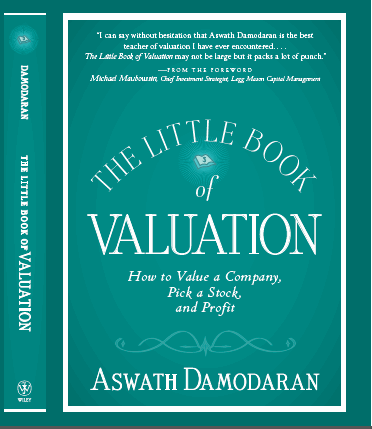 The
Little Book of Valuation
The
Little Book of Valuation Young
companies are diverse, but they share some common characteristics. In this
section, we will consider these shared attributes, with an eye on the valuation
problems/issues that they create.
1.
No history: At the risk of stating the
obvious, young companies have very limited histories. Many of them have only
one or two years of data available on operations and financing and some have
financials for only a portion of a year, for instance.
2.
Small or no revenues, operating losses:
The limited history that is available for young companies is rendered even less
useful by the fact that there is little operating detail in them. Revenues are
small or non-existent for idea companies and the expenses often are associated with
getting the business established, rather than generating revenues. In
combination, they result in significant operating losses.
3.
Dependent on private equity: While there
are a few exceptions, young businesses are dependent upon equity from private
sources, rather than public markets. At the earlier stages, the equity is
provided almost entirely by the founder (and friends and family). As the
promise of future success increases, and with it the need for more capital,
venture capitalists become a source of equity capital, in return for a share of
the ownership in the firm.
4.
Many don’t survive: Most young companies
don’t survive the test of commercial success and fail. There are several
studies that back up this statement, though they vary in the failure rates that
they find. A study of 5196 start-ups in Australia found that the annual failure
rate was in excess of 9% and that 64% of the businesses failed in a 10-year
period.[1]
Knaup and Piazza (2005,2008) used data from the
Bureau of Labor Statistics Quarterly Census of Employment and Wages (QCEW) to
compute survival statistics across firms.[2]
This census contains information on more than 8.9 million U.S. businesses in
both the public and private sector. Using a seven-year database from 1998 to
2005, the authors concluded that only 44% of all businesses that were founded
in 1998 survived at least 4 years and only 31% made it through all seven years.
In addition, they categorized firms into ten sectors and estimated survival
rates for each one. Table 9.1 presents their findings on the proportion of
firms that made it through each year for each sector and for the entire sample:
Table 9.1: Survival of new establishments founded in 1998
|
|
Proportion
of firms that were started in 1998 that survived through |
||||||
|
|
Year 1 |
Year 2 |
Year 3 |
Year 4 |
Year 5 |
Year 6 |
Year 7 |
|
Natural resources |
82.33% |
69.54% |
59.41% |
49.56% |
43.43% |
39.96% |
36.68% |
|
Construction |
80.69% |
65.73% |
53.56% |
42.59% |
36.96% |
33.36% |
29.96% |
|
Manufacturing |
84.19% |
68.67% |
56.98% |
47.41% |
40.88% |
37.03% |
33.91% |
|
Transportation |
82.58% |
66.82% |
54.70% |
44.68% |
38.21% |
34.12% |
31.02% |
|
Information |
80.75% |
62.85% |
49.49% |
37.70% |
31.24% |
28.29% |
24.78% |
|
Financial activities |
84.09% |
69.57% |
58.56% |
49.24% |
43.93% |
40.34% |
36.90% |
|
Business services |
82.32% |
66.82% |
55.13% |
44.28% |
38.11% |
34.46% |
31.08% |
|
Health services |
85.59% |
72.83% |
63.73% |
55.37% |
50.09% |
46.47% |
43.71% |
|
Leisure |
81.15% |
64.99% |
53.61% |
43.76% |
38.11% |
34.54% |
31.40% |
|
Other services |
80.72% |
64.81% |
53.32% |
43.88% |
37.05% |
32.33% |
28.77% |
|
All firms |
81.24% |
65.77% |
54.29% |
44.36% |
38.29% |
34.44% |
31.18% |
Note that survival rates vary
across sectors, with only 25% of firms in the information sector (which
includes technology) surviving 7 years, whereas almost 44% of health service
businesses make it through that period.
5.
Multiple claims on equity: The repeated
forays made by young companies to raise equity does expose equity investors,
who invested earlier in the process, to the possibility that their value can be
reduced by deals offered to subsequent equity investors. To protect their
interests, equity investors in young companies often demand and get protection
against this eventuality in the form of first claims on cash flows from
operations and in liquidation and with control or veto rights, allowing them to
have a say in the firm’s actions. As a result, different equity claims in a
young company can vary on many dimensions that can affect their value.
6.
Investments are illiquid: Since equity
investments in young firms tend to be privately held and in non-standardized
units, they are also much more illiquid than investments in their publicly
traded counterparts.
[1]
John Watson and Jim Everett, 1996, “Do Small Businesses Have High
Failure Rates?” Journal of Small Business Management, v34, pg 45-63.
[2]
Knaup, Amy E., May 2005,,
“Survival and longevity in the Business Employment Dynamics data,” Monthly
Labor Review, pp. 50–56; Knaup, Amy E. and
MC. Piazza, September 2007, Business Employment Dynamics Data: Survival and
Longevity, Monthly Labor Review, pp 3-10.